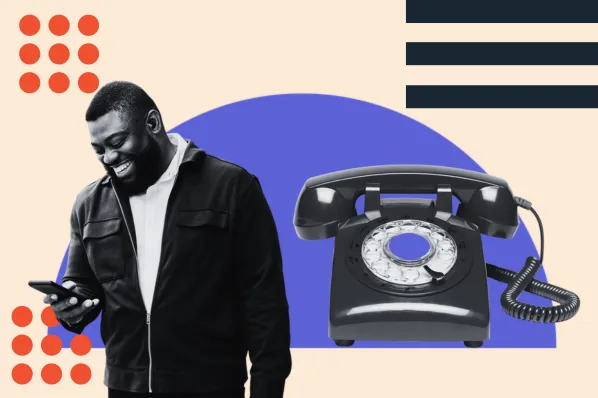Welcome to "The Pipeline" — a weekly column from HubSpot, featuring actionable advice and insight from real sales leaders.

A while back, I was at the park, and my phone rang. I rarely get phone calls, and I usually ignore them. This time, something felt different. I decided to pick up. Bad move — it was a salesperson.
Him: Hi this is Sean calling from Bulletproof Lead Gen. Do you have a min—
Me: Hey, I’m not interested. Have a great day. *hangs up*
My response is what we as salespeople face every single day. In fact, when my team and I talk to sales teams, one of the challenges we hear most about is prospecting. Finding qualified prospects is hard enough — but your work isn’t done once you find qualified prospects who match your buyer persona.
You still need to keep them interested enough to listen and buy from you and not a competitor. Here are five soundbites that we’ve found top sales reps use to develop interest in prospects and keep the conversation moving toward the close.
5 Phrases Top Salespeople Say on Prospecting Calls
1. An introduction baked with credibility.
There was nothing offensive about Sean’s introduction. He was polite and sounded well-meaning. But the moment he asked for a minute of my time, my instinctive answer was no. He didn’t explain why he called or why I should give him my time. I was relaxing in the park — not waiting for a sales pitch.
Here’s what Sean could have said instead to get my attention.
“Hi, this is Sean calling from Bulletproof Lead Gen. I’m calling because I saw that you downloaded an ebook about generating more leads earlier today. I’ve helped dozens of companies grow their leads and revenue. Would you be interested in having a conversation about how I can help your business?”
With this type of introduction, the rep immediately explains what made him call and how he hopes to help me. I’d be open to learning how I could improve my business even if I had no intentions of buying anything.
2. A business-oriented value proposition.
Value propositions often take the following form: “My product will help you achieve X, Y, and Z. Here are its 147 features.”
This approach sucks. Translate that monologue into a narrative about exactly how those features will make your prospect’s life better. By offering tangible outcomes, you make it more clear that your product or service is valuable and worth your prospect’s time.
Here’s an example of an effective value proposition written by sales expert Jill Konrath:
“We help large companies reduce the cost of their employee benefits programs without impacting benefit levels. With the spiraling costs of healthcare today, this is a critical issue for most businesses. One of our recent clients, a large manufacturing company similar to yours, was struggling with how to reduce spending in this area. We saved them over $800,000 in just six months. Plus, they didn’t cut any services to their employees, nor did their employees have to pay more.”
3. A rapport-builder.
Research shows only 3% of buyers think salespeople are trustworthy. Building rapport is an essential part of building trust with your prospect. If a prospect doesn’t trust you, they won’t buy.
Proper rapport-building requires research to find talking points with your prospect. That could mean finding their LinkedIn or Twitter profiles, their website, or other content and information they’ve shared.
Here are three examples of questions that can help you build rapport:
- “I see that your company is located in [NAME OF CITY]. I went there on a trip last month. Is your office located right in the city? Have you ever been to [NAME OF RESTAURANT / OTHER LOCATION]?”
- “I saw on your LinkedIn that you previously held a role as [ROLE] and now you’re doing [CURRENT ROLE]. How did you make that transition?”
- “I saw on Twitter that you just visited [COUNTRY]. What was the highlight of your trip?”
4. The second-level questions.
Listening doesn’t just mean being quiet and letting the prospect speak. You have to demonstrate that you’re listening. This means asking second-level questions — questions that build on the ones you’ve asked before and require inferences on your part.
Below are two phrases you can use to show that you’re open and eager to hear what your prospect’s challenges are and demonstrate that you’re listening to them by reiterating and diving deeper:
- “You’ve spoken about [X challenge]. When I encounter prospects with this problem, they’re often also facing Y and Z. How are you thinking about those areas?”
- “So what you’re telling me is… [summary of what they told you]. Will you tell me more about [specific point]?”
5. The positioning statement.
Positioning statements are a sales rep’s secret weapon. They capture the purpose of a product and how it’s used — and they help shape a line of questioning and value proposition that’ll make the prospect say, “Yes! That’s me!”
They have two goals:
- Make yourself more credible
- Qualify the prospect to make sure it makes sense to continue the conversation
Say something like: “When I talk to businesses like yours, they often face [challenges]. Are you facing these as well?”
Prospecting at scale is difficult, but with the phrases above or even a sales script, you can ensure you’re making the best use of your time.











